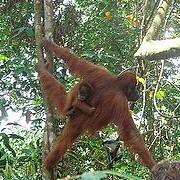 宏都拉斯的雷奧普拉塔諾生物圈保留區(Rio Platano Biosphere Reserve)與印尼蘇門達臘的熱帶雨林遺產,22日列入聯合國瀕危世界遺產名錄之中。
宏都拉斯的雷奧普拉塔諾生物圈保留區(Rio Platano Biosphere Reserve)與印尼蘇門達臘的熱帶雨林遺產,22日列入聯合國瀕危世界遺產名錄之中。
依據聯合國教科文組織(UNESCO)的自然科學獨立諮詢機構世界自然保育聯盟(IUCN)建議,教科文組織世界遺產委員會將這些地區列入其瀕危名單之中。
宏都拉斯政府要求,將其境內最大的保護區,也是中美洲少數僅存的熱帶雨林之一的雷奧普拉塔諾生物圈保留區列入瀕危名單。
由於缺乏執法能力,長期佔地的非法移民、非法捕魚、盜伐、盜獵以及在帕圖卡河(Patuca River)的水壩興建計畫,在在威脅到保護區的森林、紅樹林、沿海潟湖和大草原。
雷奧普拉塔諾生物圈保留區中,住有一群保留著在熱帶雨林中傳統生活方式的原住民,1982年被列入教科文組織的世界遺產名錄內。它首次被列入瀕危名單的時期是1996年至2007年。
世界遺產委員會在22日表示,「法律效能不彰以及毒販猖獗等主要因素」,這個地區需要更多的保護。
世界遺產保育官員 Mariam Kenza Ali 說,「我們完全支持宏都拉斯的積極行動,要求將雷奧普拉塔諾列入瀕危名單,引起國際增加對保護這個自然資產的支持,當地有超過2000位原住民是直接仰賴自然資源以維持他們的傳統生活方式。」
 教科文組織在2004年因為豐富的生物多樣性,而將蘇門達臘的熱帶雨林列入世界遺產,在22日被列入其瀕危名錄,以克服盜獵、盜伐、農業侵占以及道路興建計畫等對該地的威脅。
教科文組織在2004年因為豐富的生物多樣性,而將蘇門達臘的熱帶雨林列入世界遺產,在22日被列入其瀕危名錄,以克服盜獵、盜伐、農業侵占以及道路興建計畫等對該地的威脅。
IUCN自2004年以來一直建議將該區列入瀕危名單。過去5年來的,4個教科文組織與自然保育聯盟聯合的監測計畫,作出了這個地方極需要緊急復育計畫的結論。
IUCN的世界遺產資深顧問 Peter Shadie 表示,「將蘇門達臘雨林列入瀕危名單中,顯示出國際對這片土地的關注與支持。」
「經過多年的爭論,委員會已作出這一重要的決定,現在我們必須要確保採行實際行動,來解決長期存在的問題」,Shadie 說道。
儘管IUCN建議將俄羅斯第一個世界自然遺產科米原始林(Virgin Komi Forests)列入瀕危名單,但卻未獲採納。
IUCN表示,該地的金礦開採許可以及自然面向上的邊界變化,使得這個區域失去法律保護,都是這個地區應該列入「瀕危」的準則。
儘管面對缺乏足夠的管理、未來道路的興建計畫、遊客人數的增加以及缺乏對自然災害的預防措施等威脅。世界知名的印加文明代表馬丘比丘(Historic Sanctuary of Machu Picchu),也未被列入瀕危名單內。
從積極的方面來看,印度曼納斯野生動物保護區(Manas Wildlife Sanctuary)在保育方面的改進使其在22日由瀕危名單中除名。
坐落在喜馬拉雅山山麓,曼納斯保護區中有許多瀕危物種,像是老虎、侏儒豬、印度犀牛和印度象。
印度自1992年起,幾乎每年提出將之由瀕危名單除名的申請,但世界遺產委員會認為危險依然存在。
委員會在1998年寫道,「雖然曼納斯內部與周邊的安全有所改善,但是阿薩姆邦的暴動威脅仍然存在,武裝份子常通過保護區。然而委員會獲悉,印度當局認為該遺址的保護狀況與當地區民的關係正逐漸改善中。」
十年後,委員會敦促印度政府進行野生動物族群復原狀況的普查,建立一個完整的監測系統以間測並紀錄旗艦物種的恢復狀況。
最後,印度被要求繼續為獨角犀的野放努力,並評估沼澤鹿復育計畫的可行性。
世界遺產委員會在年度議期中審查了169個世界遺產的保育狀況,包括34個名列在瀕危名單中的世界遺產。
The Rio Platano Biosphere Reserve in Honduras and the Tropical Rainforest Heritage of Sumatra in Indonesia today were added to the United Nations' List of World Heritage in Danger.
At its annual session in Paris, the UNESCO World Heritage Committee added these areas to the Danger List following the advice of International Union for Conservation of Nature, the independent advisory body on nature to UNESCO.
One of Central America's few remaining tropical rainforests and the largest protected area in Honduras, the Rio Platano Biosphere Reserve, was inscribed on the Danger List at the request of the government of Honduras.
Lack of law enforcement has led to illegal settlement by squatters, illegal commercial fishing, illegal logging, poaching and a proposed dam construction on the Patuca River, all of which threaten the reserve's forests, mangroves, coastal lagoons and savannahs.
Rio Platano Biosphere Reserve, home to an indigenous population that has preserved its traditional way of life in the rainforest, was inscribed on UNESCO's World Heritage List in 1982. It was first inscribed on the Danger List between 1996 and 2007.
Now, the site needs more protection "notably due to the deterioration of law and to the presence of drug traffickers" the World Heritage Committee said, explaining today's Danger Listing.
Mariam Kenza Ali, IUCN World Heritage Conservation Officer, said, "We fully support Honduras' positive move to request Rio Platano to be included in the List of World Heritage in Danger and signal the need for increased international support to protect the natural wealth of this site, where over 2,000 indigenous people continue their traditional way of living, directly dependant on natural resources."
The Tropical Rainforest Heritage of Sumatra, inscribed on UNESCO's World Heritage List in 2004 for its wealth of biodiversity, was today placed on the Danger List to help overcome threats posed by poaching, illegal logging, agricultural encroachment, and plans to build roads through the site.
IUCN has consistently recommended the site to be included on the Danger list since 2004. Four joint UNESCO-IUCN monitoring missions in the last five years have led to the conclusion that the site needs an emergency restoration plan.
"Including the exceptional Sumatran rainforests on the Danger list today signals a message of international concern to support this site," said Peter Shadie, IUCN's senior adviser on World Heritage.
"The Committee has taken this important decision after several years of debate, and we now need to ensure that it leads to real action on the ground to tackle long standing threats," said Shadie.
The Virgin Komi Forests, Russia's first natural site added to the World Heritage List, was not added to the Danger List, despite IUCN's recommendation.
The approval of a gold mine inside the site and national level boundary changes, which led to the loss of legal protection for these areas, are both clear criteria for a site to be declared "in danger," according to IUCN.
The Historic Sanctuary of Machu Picchu, the world's most renowned icon of the Inca civilization, was also not added to the Danger List, despite threats such as lack of adequate governance, future construction of a road, impacts of the growth of numbers of visitors and lack of preventive measures against natural disasters.
On the positive side, improvements in the conservation status of India's Manas Wildlife Sanctuary allowed for its withdrawal today from the List of World Heritage in Danger.
Situated on the foothills of the Himalayas, the Manas sanctuary is inhabited by many endangered species, such as tigers, pygmy hogs, Indian rhinos and Indian elephants.
India has applied nearly every year since 1992 for removal of the sanctuary from the Danger List, but the World Heritage Committee decided that dangers still existed.
In 1998, the committee wrote, "While security conditions in and around Manas have improved, the threat of insurgency still prevails in the State of Assam and militants often traversed the Sanctuary.
Nevertheless, the Committee was informed that the Indian authorities were of the view that conditions for site protection and the relationship with local villagers were gradually improving."
Ten years later, the committee urged India to conduct a baseline survey on recovery of wildlife populations and set up a full monitoring system which will allow monitoring and documenting the recovery of the flagship species.
Finally, India was urged to continue with efforts for reintroduction of the one-horned rhino and assess the feasibility of a restoration program for swamp deer.
In the coming days, the World Heritage Committee will examine the state of conservation of 169 World Heritage properties, including 34 on the List of World Heritage in Danger.
全文及圖片詳見:ENS報導








